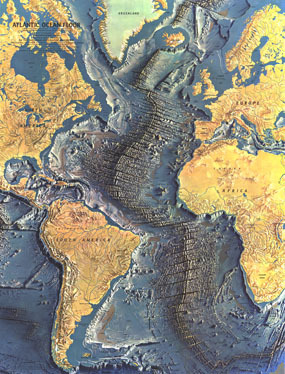
A rift runs down the middle of the Atlantic. This underwater mountain range spans the globe, like the stitching of a tennis ball.
During the late 1940s and 1950s huge advances were made in mapping the ocean floors of the world.[1]
Scientists had expected the ocean basins to be featureless plains, smoothed over by thick layers of sediment washed down from the continents.[2] They assumed too that the rock at the bottom of the ocean floor was made of the same basic stuff as the continents.
But all of this was wrong. Rather than the featureless void they had expected, the ocean floors were riddled with complicated mountain ranges and valleys. When scientists probed the rock with echo-sounders, they found that the ocean crust was much thinner than the continental crust and practically the same thickness across the globe. There was also a lot less sediment on top than predicted.[3]
With so many puzzles, the theory of the ocean floor was ripe for a grand solution.
See also Wikipedia: History of Oceanography.
Early work on the ocean floor had been done by the Challenger expedition in the 1870s, using sounding techniques that involved seeing how far a rope with lead at the end would drop.
In the 1940s and 1950s echo sounding was used to get a more detailed picture of the ocean floor. Much of the funding was provided by the US Navy, who were interested in the sea floor because of the increased use of submarines during the Cold War. One such crucial expedition was the MidPac expedition, which discovered the Mid-Pacific Mountain Range.
The issue of sediment presented a paradox. If the Earth's surface was completely static, why had all the mountains on the continents not been worn away by weathering and filled up the oceans as sediment? This paradox is another on the list that was solved by plate tectonics.
More powerful echo-sounders used explosives set off at the surface to explore the rock below the water. The ocean crust has a roughly constant thickness, around 7 kilometres thick. Below it is the mantle. On top there is on average around half a kilometre of sediment (figures from Wikipedia: Ocean Crust).
Author: Tom Brown
Copyright: public domain
Date last modified: 7th Oct 2011
Peer-review status: Not yet peer-reviewed
mid_atlantic_rift.jpg: source: google search for "atlantic sea floor"; http://www.maps.com/map.aspx?pid=15757 copyright: unknown